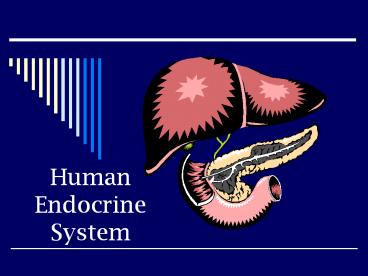Human Endocrine System - PowerPoint PPT Presentation
Title:
Human Endocrine System
Description:
Human Endocrine System Human Endocrine System The endocrine system consists of ductless glands that produce hormones Hypothalamus, pituitary, pineal, thyroid ... – PowerPoint PPT presentation
Number of Views:104
Avg rating:3.0/5.0
Title: Human Endocrine System
1
Human Endocrine System
2
Human Endocrine System
- The endocrine system consists of ductless glands
that produce hormones - Hypothalamus, pituitary, pineal, thyroid,
parathyroid, thymus, adrenal, pancreas, ovary,
testes - Hormones are chemical messengers that travel
through the blood stream and affect activities
throughout the body. - Steroid hormones
- Nonsteroid hormones
3
Hormones
- Hormones are chemical messengers that bind to
target cells and affect cell activities - Nonsteroid hormones are made from amino acids and
generally cannot pass through the cell membrane.
These hormones bind to a receptor site on the
outside of a cell in order to initiate chemical
reactions inside the cell. - Steroid hormones are produced from the lipid,
cholesterol and are able to pass through cell
membranes and bind to receptor proteins.
4
Nonsteroid hormones cannot go through cell
membrane, must activate proteins in the cell
membrane
Steroid hormones can go through cell membrane
to reach receptors inside the cell
5
- Hormones have specific shapes that fit receptors
or the surface of the target organ or structure
they are going to influence - Bind with cell receptors
- If incorrect receptor the particular hormone has
no effect
6
(No Transcript)
7
(No Transcript)
8
The Brain
Pituitary gland biology Animation Endocrine
Glands biology Animation
Section 35-3
9
The Endocrine Glands
Section 39-1
Pineal gland The pineal gland releases melatonin,
which is involved in rhythmic activities, such as
daily sleep-wake cycles.
Hypothalamus The hypothalamus makes hormones that
control the pituitary gland. In addition, it
makes hormones that are stored in the pituitary
gland.
Thyroid The thyroid produces thyroxine, which
regulates metabolism.
Pituitary gland The pituitary gland produces
hormones that regulate many of the other
endocrine glands.
Pancreas The pancreas produces insulin and
glucagon, which regulate the level of glucose in
the blood.
Parathyroid glands These four glands release
parathyroid hormone, which regulate the level of
calcium in the blood.
Ovary The ovaries produce estrogen and
progesterone. Estrogen is required for the
development of secondary sex characteristics and
for the development of eggs. Progesterone
prepares the uterus for a fertilized egg.
Thymus During childhood, the thymus releases
thymosin, which stimulates Tcell development.
Testis The testes produce testosterone, which is
responsible for sperm production and the
development of male secondary sex characteristics
Adrenal glands The adrenal glands release
epinephrine and nonepinephrine, which help the
body deal with stress.
10
Glands I
- Hypothalamus coordinates activities of the
nervous and endocrine systems and produces
hormones to regulate the pituitary gland - Pituitary produces hormones that direct the
activities of other endocrine glands - Pineal releases melatonin which is involved in
rhythmic or cyclic activities - Thyroid produces hormones that regulate
metabolism and development - Parathyroid helps maintain appropriate calcium
levels
11
Glands II
- Thymus involved with immune development during
childhood - Adrenal regulates the bodys stress response
(epinephrine, norepinephrine, cortisol,
aldosterone) - Pancreas controls glucose levels in the blood
(insulin, glucagon) - Ovary secretes estrogen and progesterone to
regulate reproduction - Testes produces testosterone to control
formation of sperm and sexual behavior
12
Negative Feedback
- The level of one hormone in the blood inhibits or
stimulates the production of another hormone or
substance - Homeostasis biology Animation
13
CONTROL OF THE ENDOCRINE SYSTEM
- REGULATED BY FEEDBACK MECHANISMS
- EX HEATING SYSTEMS
14
Negative Feedback
- The release of hormones is controlled through a
negative feedback system - Negative feedback systems are control mechanisms
that operate by inhibiting a process or activity
that originally led to starting the process or
activity - For example, as glucose levels in the body
increase, sensors in the pancreas signal the
release of the hormone insulin - Insulin promotes the entry of glucose into cells,
lowering glucose levels - As the glucose levels in the blood decrease, the
pancreas stops secreting insulin.
15
(No Transcript)
16
Actions of Insulin and Glucagon
Section 39-2
Beta cells release insulin into the blood
Body cells absorb glucose
Blood glucose level decreases
Blood glucose level increases
Liver converts glycogen to glucose
Homeostasis Normal blood glucose level
Blood glucose level decreases
Blood glucose level increases
Alpha cells release glucagon into blood
Liver converts glycogen to glucose
17
Disorders
- Goiter
- Enlargement of the thyroid gland due to the
inability to manufacture thyroxin
(hypothyroidism) - Graves Disease
- Hyperthyroidism- over secretion of thyroxin
- Diabetes
- Insulin deficiency which results in elevated
blood sugar level
18
Symptoms of Diabetes
- Excessive thirst
- Frequent urination
- Extreme hunger
- Unexplained weight loss
- Glucose in urine
- Fatigue
- Vision problems
- Numbness tingling in extremities
- High infection rate
19
Concept Map
Section 39-2
The Endocrine System
regulates
by meansof the
by meansof the
by meansof the
by meansof the
by meansof the
by meansof the































